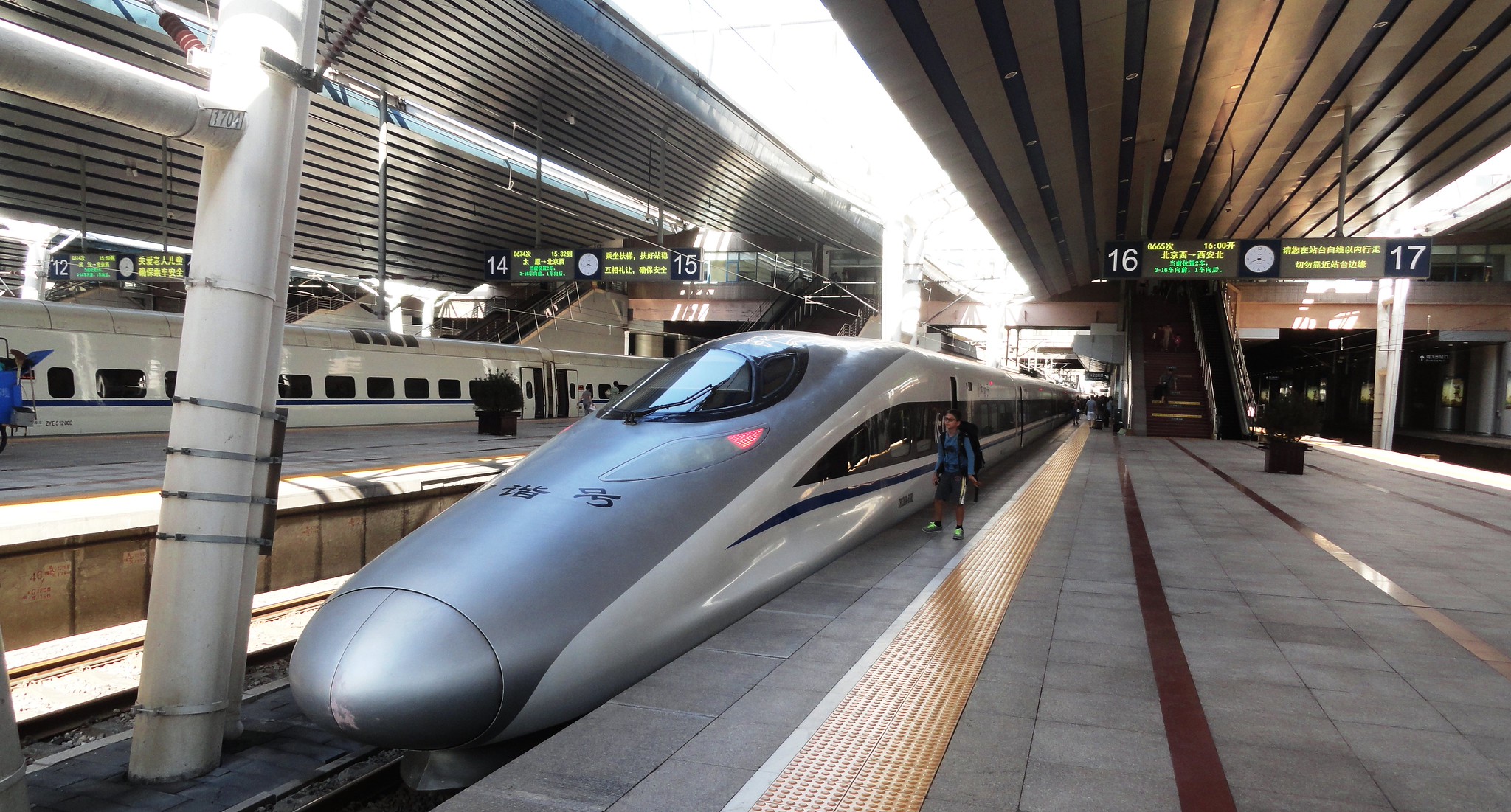By now there's a firmly established genre of media coverage about the transformation of Los Angeles from America's freeway capital to a 21st century transit city. It's an appealing narrative: The poster child for car-centric urban sprawl learning to embrace trains, buses, and walking. And it's grounded in major victories at the ballot box, where Angelenos twice voted to tax themselves to raise billions for transit.
But the truth is a little less dramatic. By the (admittedly low) standards of American cities, L.A.'s transit service was never that bad, while its purported transit renaissance has yet to translate into more people opting for buses and trains.
Given the tens of billions of dollars that L.A. will spend on transit over the next few decades, it's all the more important to invest it in ways that will be useful and attract riders. But since 2014, ridership has been dropping. If L.A. is going to become a good transit city, first it has to reckon with why this key indicator is trending in the wrong direction.
As we kick off the L.A. portion of our Getting Transit Right series, I'll explore the current state of bus and train service in the region -- and what it tells us about how L.A. can make transit useful to more people.
Frequent transit covers a lot of turf -- but not all day
The largest transit operator in the region of 10 million people is L.A. Metro, which runs an extensive bus network, the region’s light and heavy rail lines, and even the local bike-share system. L.A. Metro led the campaigns for Measure M and Measure R, the ballot initiatives that will fund transit investments for decades.
In the city of L.A. (population 3.8 million), about 10 percent of workers commute by transit. That’s not much compared to cities like Boston or New York, but it’s a lot more than any other major city in the Sunbelt. In the L.A. region as a whole, the transit commute mode share is about 5.6 percent.
At peak hours, most of the region's populated areas have access to transit that comes at least every 15 minutes on the L.A. Metro network, as shown on the following map (which does not include services provided by municipal bus operators):
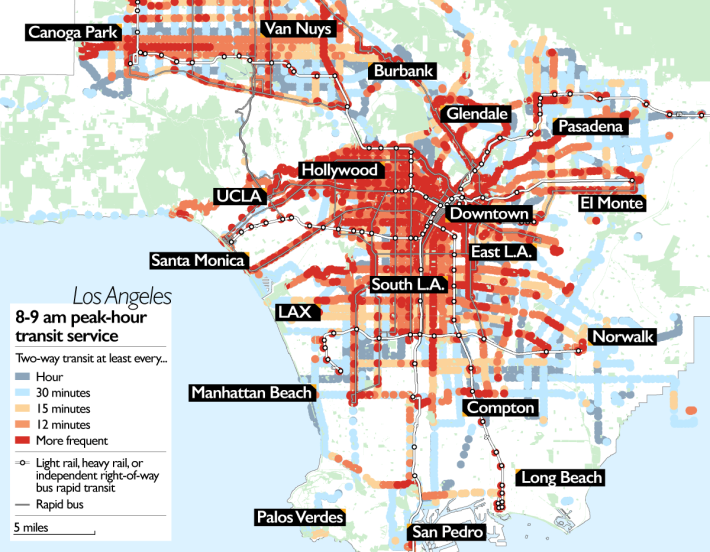
Off-peak, however, frequent service is far less extensive, with many of the lines in areas like Norwalk or the San Fernando Valley (such as around Van Nuys) not running very often:
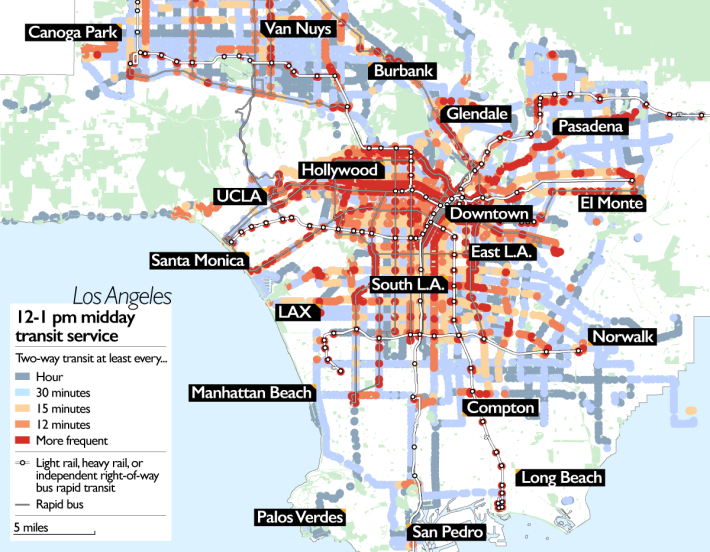
Still, while only about 10.6 percent of L.A. County’s population lives within a half-mile of a rail or BRT line, according to my calculations, almost half -- or about 4.6 million people -- live within a half-mile of an L.A. Metro transit line that arrives at least every 15 minutes at off-peak hours. About 2.8 million live within a quarter-mile of such routes.
Transit access to jobs, meanwhile, is best along the corridor extending from downtown to Santa Monica, roughly along Wilshire Boulevard -- in part because that’s also the area with the greatest concentration of employment. In the rest of the region, job access via transit is not very good, with residents typically able to reach fewer than 50,000 jobs in 30 minutes or less via transit.
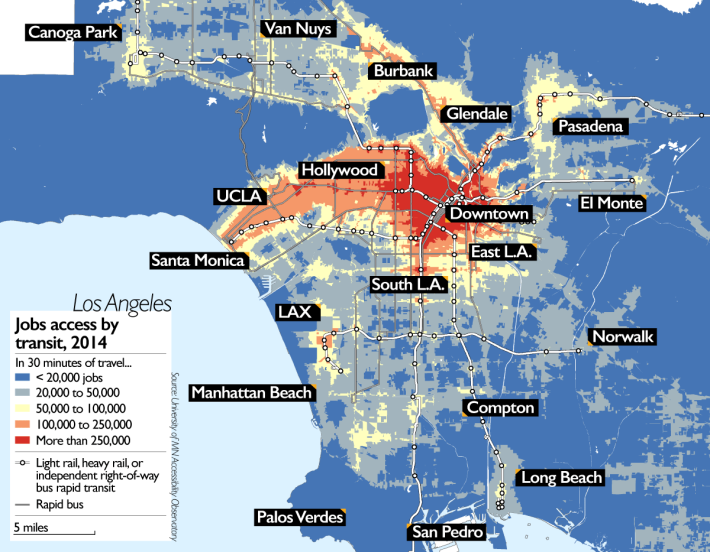
One way to improve transit access to jobs -- and the usefulness of L.A. transit in general -- is to tackle problems with the bus network, including slow speeds and a lack of reliability.
The decline of bus service is a very big problem
Despite passing a large new funding package in 2008 through Measure R, L.A. Metro began cutting service substantially in 2010. L.A. now spends far less per capita to operate buses and trains ($217) than Chicago ($303), D.C. ($450), or Seattle ($795).
The 2010 cuts reduced total hours of bus service by about 10 percent. But the cuts were far more severe in terms of the mileage that bus routes cover. Today, though L.A. Metro is operating only about 5 percent fewer bus hours than in 2005, it is operating almost 20 percent fewer bus miles.
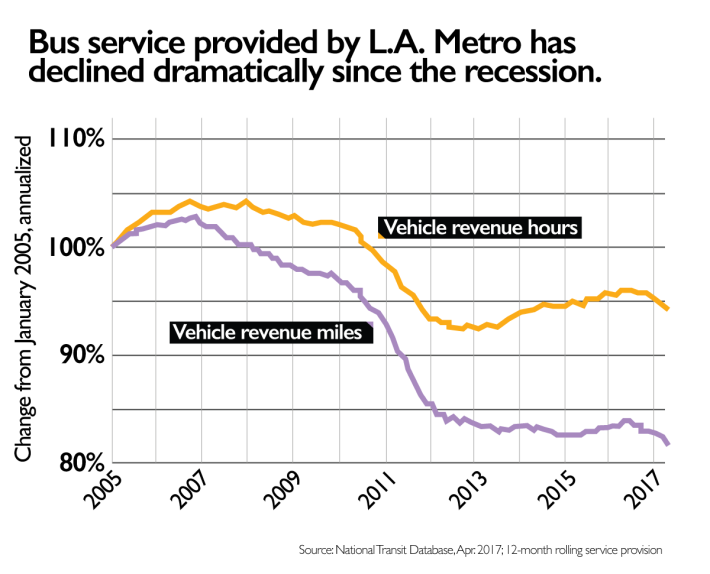
This discrepancy helps convey the massive decline in average bus speeds over the past 12 years. The average L.A. Metro bus now travels almost two mph -- or 13 percent -- slower than it did in 2005. So not only do L.A. riders get less bus service than they once did -- they also get slower service.
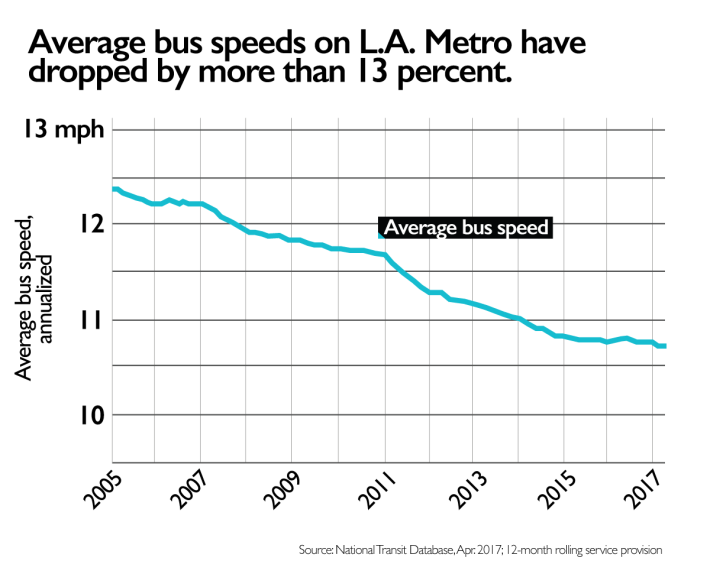
After a decade of relatively steady ridership, the L.A. region has suffered a significant drop in transit trips since late in 2014. The region’s transit services now carry more than 100 million fewer passengers annually than they did just three years ago. That’s a huge decline.
L.A. Metro has a growing rail network, but increases in rail ridership have been nowhere close to making up for losses on the agency’s buses:
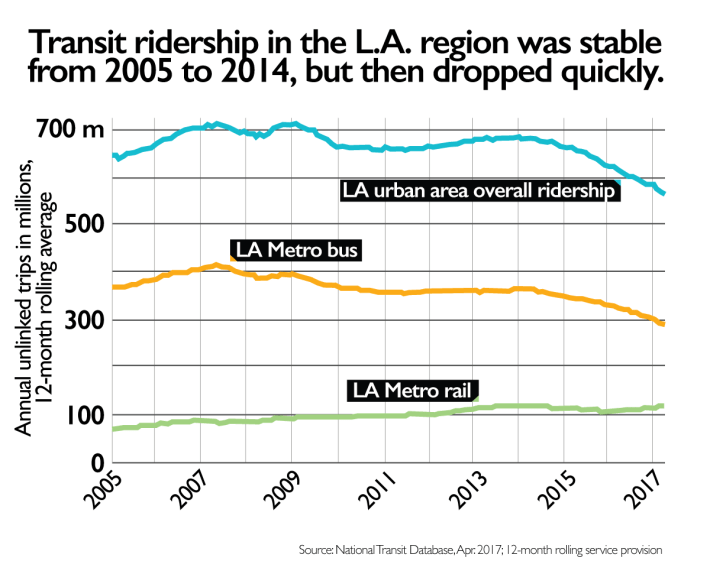
L.A. must find a way to reverse the deterioration of bus service. Several factors could explain the loss of ridership, which is a national trend, but planners at L.A. Metro told me the major culprit for declining local bus speeds is likely increasing traffic congestion. This strongly suggests that L.A. Metro and L.A. DOT have not taken sufficient steps to prioritize buses and provide riders with service that bypasses car traffic on city streets.
Beyond L.A. Metro
L.A. Metro is the largest of more than two dozen agencies providing transit in the metropolitan area, from commuter rail run by Metrolink to buses run by city governments. Most allow users to pay with the Tap card, which eases transfers between agencies.
Other parts of the regional transit system are also underperforming dismally. Metrolink, the commuter rail system, is a good example. While it offers reasonably frequent train service from throughout southern California into central Los Angeles during peak hours, service is lacking the rest of the day. Want to travel from downtown Riverside, a city of more than 300,000 people, to downtown L.A.? There are no trains available between 8:10 a.m. and 3:07 p.m. It's no surprise then that Metrolink carries fewer daily passengers than its Bay Area cousin Caltrain, despite having seven times as many route miles.
Grading Los Angeles transit service
L.A. has an extensive network of frequent transit service during rush hour. But outside of rush hour, buses come much less often. Despite an expanding rail network, service cuts and slower bus speeds have sapped overall transit ridership the last few years. There are many challenges and opportunities ahead for L.A. transit -- but one of the absolute top priorities has to be making bus service a faster, more reliable option.

Strengths
- Basic local transit service covers a very large area, with the highest transit mode share among major cities in the Sunbelt.
- About half the region’s population currently has reasonable walking access to all-day, frequent bus service.
- Good regional coordination between an array of different transit providers, exemplified by the interoperability of the Tap fare card on most local systems.
Weaknesses
- Bus service quality has declined in recent years as speeds have slowed.
- The fall-off in bus ridership has not been compensated for by increases in rail ridership.
- Good transit access to jobs is concentrated in one part of the region -- the downtown-to-westside corridor.
Coming next
One of the biggest challenges for L.A. is its sheer geographic size. L.A. County has about 20 percent more people than New York City but is spread out over an area that is more than 13 times larger. Moreover, employment is perhaps less centralized in L.A. than in any other major region. This poses specific problems when it comes to reorienting land use to align with transit. In the next post in this series, I’ll delve into how the city is planning to address these issues.



